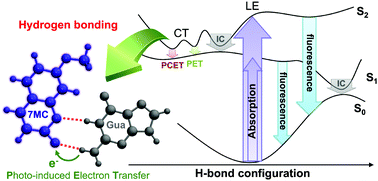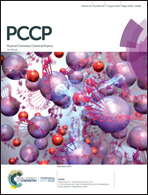Fluorescence quenching by photoinduced electron transfer between 7-methoxycoumarin and guanine base facilitated by hydrogen bonds: an in silico study†
Abstract
In this study, the effects of hydrogen bond (H-bond) formation on fluorescence quenching of 7-methoxycoumarin (7MC) via photo-induced electron transfer from a guanine base (Gua) are investigated using a combined quantum mechanics/molecular mechanics simulation. The electronic structure is calculated by the floating occupation molecular orbital complete active space configuration interaction modification on a semiempirical method. Then the full multiple spawning method is employed for the dynamics simulations on multiple electronic states. The methods employed here are validated by simulating direct dynamics of 7MC (without Gua) and compared with available experimental results. Our computational results are in good agreement with the previously reported experimental results in terms of spectroscopic properties of 7MC. In the case of a H-bonded 7MC–Gua complex, the results from constrained dynamics simulations and single-point calculations suggest that the electron transfer occurs on the second excited state and it depends not only on the H-bond length but also on the intermolecular planarity between 7MC and Gua. Moreover, a proton coupled electron transfer can occur at ≈1 Å of H-bond length, where a proton from Gua is also transferred together with the electron to 7MC. The obtained simulations are expected to be greatly beneficial for designing effective fluorescently labeled nucleotide probes as well as providing information for precise fluorescence signal interpretation.



 Please wait while we load your content...
Please wait while we load your content...